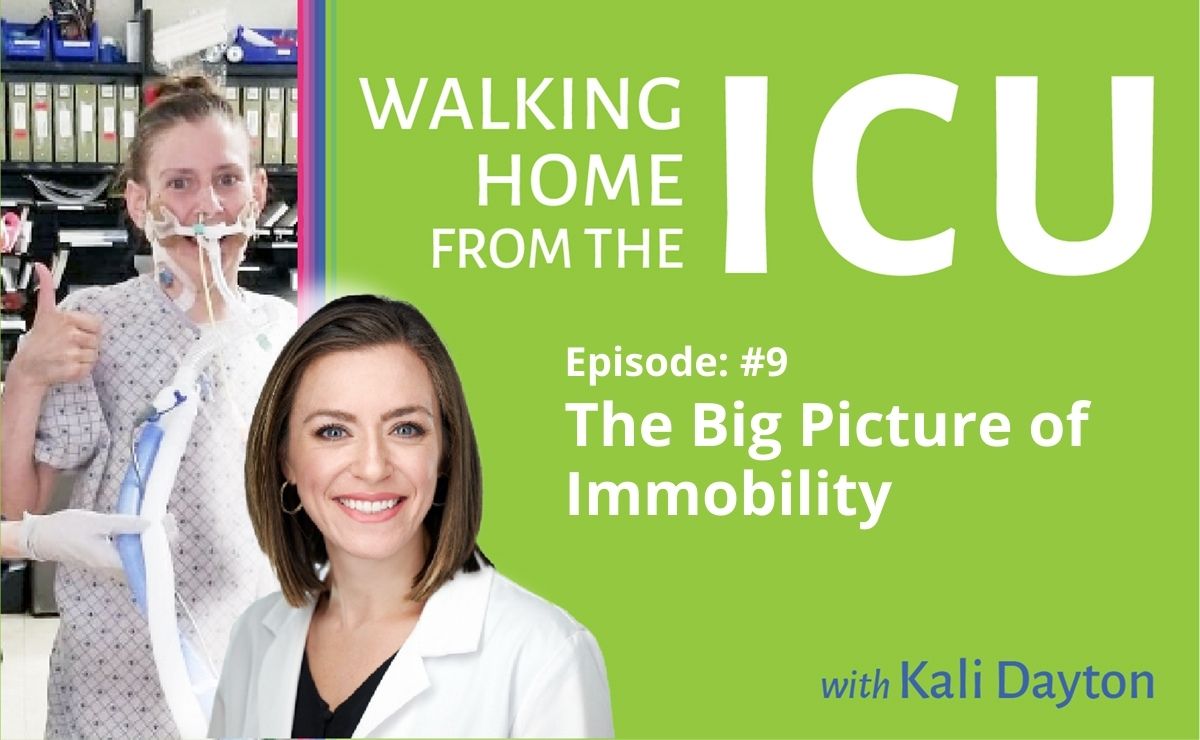SUBSCRIBE TO THE PODCAST
What happens down the road to patients that are on bedrest during their time on the ventilator? Is there another way? Let’s put it into the big picture.
Episode Transcription
Kali Dayton 0:28
Now I want to talk about some things that will make us as ICU providers a little uncomfortable. So buckle up and stay with me. Patients come into our ICUs and require mechanical ventilation for so many different reasons. Sepsis stroke, pneumonia, pulmonary hemorrhage, the list is too long to attempt. For decades, standard of care has been to sedate patients on mechanical ventilation with the aetiology that this will be more comfortable to them and that they will tolerate the ventilator better.
The past six episodes have been dedicated to the psychological and mental damage, prolonged sedation causes, we could spend another 10 episodes on it. But I think for now, we get we break brains. This episode, I want to explore what it is like to be physically impaired from prolonged immobility. In the past few years, researchers have started looking at the repercussions of weeks to months of immobility, they call the result ICU acquired weakness.
The cause of ICU acquired a weakness is multifactorial with factors like sepsis steroid use multi organ dysfunction being part of the picture, yet one of the main risk factors identified is time on the ventilator. Could this have such a strong correlation to weakness, because the longer someone is on the ventilator, the longer they are sedated. And the longer they are comatose, the longer they are unable to move, we’re going to talk theoretically, I’m going to use myself as an example since I don’t think anyone wants to imagine themselves or their worst enemy, in this scenario. I’m a healthy 30 year old, I do functional fitness five days a week all around two kids, I’m pretty strong and active.
If I were to lay in bed for the next two to three weeks, and let’s say I magically haven’t terrible feeding and my bathroom needs are taken care of. I don’t move a muscle besides breathe. For the next, let’s say three weeks, it is going to be very hard, if at all possible for me to lift my extremities against gravity, let alone set up, hold my head up or in forget walking after that time. Now let’s say I was on the ventilator on a controlled setting. So now my diaphragm, which is a muscle doesn’t have to do any of the work for three weeks. What has happened to my ability for my diaphragm to drop and take my own breaths.
If I can’t hold my own head up, will I be able to protect my airway, have enough tidal volume to cough strong enough to clear secretions and what has happened to my swallow? How did I suddenly become a huge aspiration risk just from resting for three weeks. Though at that point, I’d probably have pneumonia from just laying there. Even starting out with out any medical conditions, I would have developed such weakness that I would have become ventilator dependent. The longer I lay there deconditioning or as I call it decomposing, the longer it will take me to rehabilitate rehabilitate, the further I am from ever being functional again. And the more quickly iron myself a tracheostomy and LTACH admission all to rebuild the bodily functions I lost during those weeks of laying there.
The weakness alone increases my likelihood of death. I may never be the same again. If this sounds like possible outcomes to this theoretical situation on a healthy, strong 30 year old, then how much more important is it to prevent this kind of weakness on our malnourished, geriatric obese on steroids, and our critically ill patients with other risk factors. It has been shown that early mobility and even early walking in the ICU is safe and feasible. We also see that we’re failing to mobilize even our stable patient. I know physical therapists are jumping in their seats to hear this soapbox. It’s because they get it. The rest of the medical team has grossly overlooked the big picture of the body and lives. We’ve been so disconnected with the value of function that we put that on hold while we treat the infection. Meanwhile, bodies and brains are breaking because we have failed to preserve them while treating the other acute problems.
This is why physical therapy and occupational therapy are some of my first admission orders. Almost all of our patients are up and walking three times a day, even the day they’re intubated. I can brag about this because I feel like I have little to do with it. It is the nurse, the respiratory therapist, the physical therapist, the texts that make this happen. They know that if there’s one thing we can control about their outcomes, it is that they can stay strong and functional. This has resulted in 98% of our survivors being discharged straight home compared to 46%, with the same APACHI scores, and an outside hospital.
There is no way to truly appreciate these outcomes unless we understand what it is like for patients who have received the standard treatment of sedation and immobility. What happens to patients after they have not moved for weeks or more well and medically induced comas. Do we know what their journey in rehab is like? Do we know what their new lives of disability are like even when they’re home? Do we know what it’s like for their loved ones that are now their full time caregivers. I get it I really do. The ICU is so busy. We are running ragged sometimes just to keep patients alive for one more hour.
When our patients finally roll out of the ICU headed to LTACH with tracheostomy and peg tubes. We’re already prepping the room for the next dying patient. So let’s take this moment right now to stop and really talk about it. When patients are sedated and immobile on the ventilator for over a week, they develop ICU acquired weakness. Statistically ICU acquired a weakness results in 20 additional days of mechanical ventilation and higher mortality rates. It doesn’t stop there though.
60% of those patients continue to experience muscle dysfunction up to one year after discharge, and citations and resources are on the blog. It has been shown that tricky ostomies are the result of a failure to wean from the ventilator ICU acquired a weakness results in failure to wean from the ventilator. When we allow patients to become so weak, they cannot hold their own heads up and take their own breaths, then we know that they will need mechanical ventilation for a lot longer.
Apparently 20 plus additional days. So now we have fixed the acute problems. But we may have created longer lasting problems with a weak ventilator dependent patients on our hands. So we trach them and send them elsewhere to repair the damage that has been done the past weeks under sedation. Tricky ostomies are not without long term consequences either. Almost 14% of survivors with tracheostomies have tracheal stenosis and 25% have subglottic stenosis.
We perhaps subconsciously assume that since the sepsis or whatever is resolved, that they will just pop back onto their feet and move on with their lives. When we hear it from survivors themselves, our perspectives humbled and clarified. Once we realize how much they suffer, we need to stop and ask ourselves, Is it really necessary? Are all these tricky ostomies and Eltech admissions, inevitable consequences of critical illness? Some inevitable cases may be ECMO or trauma neuro cases.
Yet, my experience in the ICU I work in has shown me that patients with even the worst respiratory failure that are allowed to be awake and moving right away and throughout their ICU stay do not need tricky ostomies or LTACH admissions. They stay strong and functional. And just as the research shows, they went off the ventilator quicker and successfully. They walk out of the hospital doors and go straight home because they never stopped walking. This should be the standard deep sedation, immobility tricky ostomies and Altech admissions should be the extreme exception. Studies have shown that post ICU PTSD is worse when physical function is worse. Better physical function predicted subsequent remission of general anxiety and PTSD symptoms.
When asking survivors about their PTSD, Jim Renninger, piped up and said that his experience was different. He was one of the very few that did not have experiences under sedation. He says that his experience and his PTSD is from waking up, unable to move his body because of the weakness. He and his wife share their story of months of ARDS and months of rehabilitation and the next episode so stay tuned.
Transcribed by https://otter.ai
SUBSCRIBE TO THE PODCAST



 When patients are so ill that they require a ventilator in the ICU, the antiquated approach of heavy sedation and immobilization should be avoided in order to help prevent the immense burden of physical and cognitive disabilities suffered during survival. To understand this better, listen to Walking Home From The ICU. You will see what ICU consultant Kali Dayton provides to your team.
When patients are so ill that they require a ventilator in the ICU, the antiquated approach of heavy sedation and immobilization should be avoided in order to help prevent the immense burden of physical and cognitive disabilities suffered during survival. To understand this better, listen to Walking Home From The ICU. You will see what ICU consultant Kali Dayton provides to your team.
